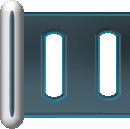|
Only exclusively aquatic mammals, cétacés_ whales, dolphins and marsouins_ have behind them more than 40 million years of evolution. Their perfect adaptation to a navy existence is reflected in their anatomy. There are however numerous manners "to build" an animal suited to a given lifestyle. By analyzing the anatomy of cetaceans, it is necessary to keep(guard) for the spirit this interrogation: « why are these creatures built so and not otherwise? » It is because the "shaping" of a human being is a function of historic, functional and structural constraints. The reconstruction of the past of an animal bases itself on ancestral physical structures which are hardly modified during times. So, cetaceans offer of numerous outbuildings with all other mammals: let us quote hairs (although reduced to the state of vestige), a heart in four compartments, a lower jaw established(constituted) by a unique(only) bone, the presence of three ossicles in the average ear, mammary glands and a placenta. Let us note that the existence of these shared peculiarities is not inevitably required by a navy life. This structures "history" betrays especially the filiation of animals and reveal the family relationships which unite them to the other human beings. In that case handbook, they prove us that in spite of their misleading appearance cetaceans are close to the other mammals. The slender body of cetaceans is not one characteristics "history": as for the other vertebrates aquatiques_ fishes, sharks, seals and pingouins_ sound curves, as relief by the drainage of the water, is the one who offers least resistance to the progress. This adaptation is an example of "functional" constraint on the morphology: she underlines the immediate needs required by the daily life. To cetaceans, the other structures are the result of the same environmental requirements: among them, let us quote the ex-members flattened in battledores and the often prominent dorsal aileron which doubtless controls the plate of the animal during the swimming. |


